2001 SUBARU IMPREZA steering wheel
[x] Cancel search: steering wheelPage 8 of 316
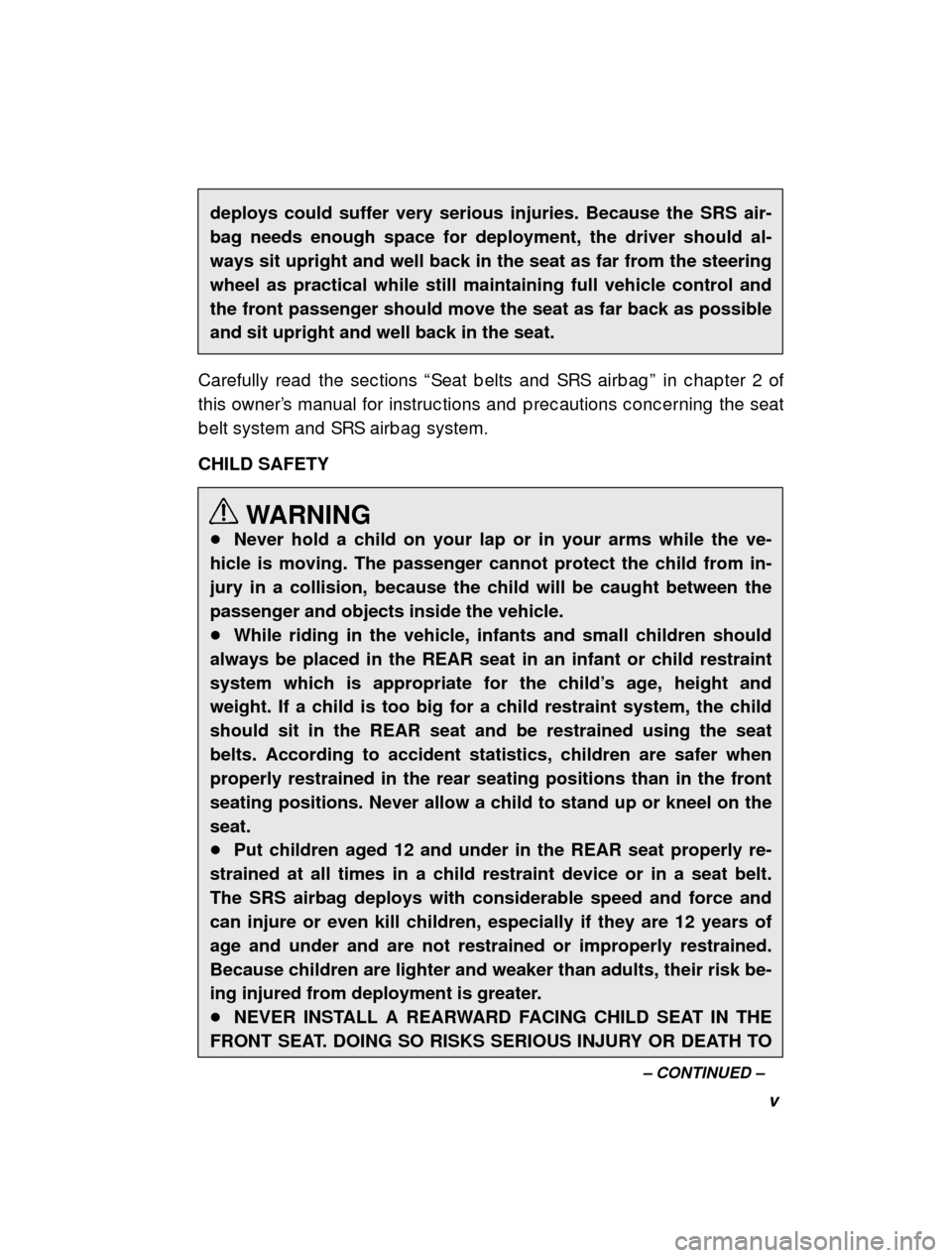
v
–
CONTINUED –
deploys could suffer very serious injuries. Because the SRS air- bag needs enough space for deployment, the driver should al-ways sit upright and well back in the seat as far from the steeringwheel as practical while still maintaining full vehicle control and
the front passenger should move the seat as far back as possibleand sit upright and well back in the seat.
Carefully read the sec tions “Seat b elts and SRS airb ag ” in c hap ter 2 of
this owner ’s manual for instruc tions and p rec autions c onc ernin g the seat
b elt system and SRS airb ag system. CHILD SAFETY
WARNING
� Never hold a child on your lap or in your arms while the ve-
hicle is moving. The passenger cannot protect the child from in- jury in a collision, because the child will be caught between the
passenger and objects inside the vehicle.� While riding in the vehicle, infants and small children should
always be placed in the REAR seat in an infant or child restraint
system which is appropriate for the child ’s age, height and
weight. If a child is too big for a child restraint system, the childshould sit in the REAR seat and be restrained using the seatbelts. According to accident statistics, children are safer whenproperly restrained in the rear seating positions than in the frontseating positions. Never allow a child to stand up or kneel on theseat.� Put children aged 12 and under in the REAR seat properly re-
strained at all times in a child restraint device or in a seat belt.The SRS airbag deploys with considerable speed and force andcan injure or even kill children, especially if they are 12 years ofage and under and are not restrained or improperly restrained.
Because children are lighter and weaker than adults, their risk be-
ing injured from deployment is greater.� NEVER INSTALL A REARWARD FACING CHILD SEAT IN THE
FRONT SEAT. DOING SO RISKS SERIOUS INJURY OR DEATH TO
Page 21 of 316

13-8T
Tac hometer (if eq uip p ed )
3-3
. . . . . . . . . . . . . . . . . . . . . . . . . . . . . . . . . . . . . . . . . . . . . . . . . . . . . .
Temp erature A, B, C 12-3
. . . . . . . . . . . . . . . . . . . . . . . . . . . . . . . . . . . . . . . . . . . . . . . . . . . . . . . . . . . . .
Temp erature g aug e 3-4
. . . . . . . . . . . . . . . . . . . . . . . . . . . . . . . . . . . . . . . . . . . . . . . . . . . . . . . . . . . . . .
Temp orary sp are tire 8-11
. . . . . . . . . . . . . . . . . . . . . . . . . . . . . . . . . . . . . . . . . . . . . . . . . . . . . . . . . . . .
Tilt steering wheel 7-26
. . . . . . . . . . . . . . . . . . . . . . . . . . . . . . . . . . . . . . . . . . . . . . . . . . . . . . . . . . . . . . . .
Tire c hains 7-46
. . . . . . . . . . . . . . . . . . . . . . . . . . . . . . . . . . . . . . . . . . . . . . . . . . . . . . . . . . . . . . . . . . . . . . . . .
Tire c hang ing tools 8-13
. . . . . . . . . . . . . . . . . . . . . . . . . . . . . . . . . . . . . . . . . . . . . . . . . . . . . . . . . . . . . .
Tire p ressure 10-39
. . . . . . . . . . . . . . . . . . . . . . . . . . . . . . . . . . . . . . . . . . . . . . . . . . . . . . . . . . . . . . . . . . . . . . .
Tire rotation 10-40
. . . . . . . . . . . . . . . . . . . . . . . . . . . . . . . . . . . . . . . . . . . . . . . . . . . . . . . . . . . . . . . . . . . . . . . .
Tires 11-4
. . . . . . . . . . . . . . . . . . . . . . . . . . . . . . . . . . . . . . . . . . . . . . . . . . . . . . . . . . . . . . . . . . . . . . . . . . . . . . . . . .
Tires and wheels 10-39
. . . . . . . . . . . . . . . . . . . . . . . . . . . . . . . . . . . . . . . . . . . . . . . . . . . . . . . . . . . . . . . . .
Top tether anc horag es 2-25
. . . . . . . . . . . . . . . . . . . . . . . . . . . . . . . . . . . . . . . . . . . . . . . . . . . . . . . . . .
Towing 8-14
. . . . . . . . . . . . . . . . . . . . . . . . . . . . . . . . . . . . . . . . . . . . . . . . . . . . . . . . . . . . . . . . . . . . . . . . . . . . . . .
Towing eyelets 8-17
. . . . . . . . . . . . . . . . . . . . . . . . . . . . . . . . . . . . . . . . . . . . . . . . . . . . . . . . . . . . . . . . . . . .
Trac tion AA, A, B, C 12-2
. . . . . . . . . . . . . . . . . . . . . . . . . . . . . . . . . . . . . . . . . . . . . . . . . . . . . . . . . . . . .
Trailer hitc hes 7-51
. . . . . . . . . . . . . . . . . . . . . . . . . . . . . . . . . . . . . . . . . . . . . . . . . . . . . . . . . . . . . . . . . . . . .
Trailer towing 7-49
. . . . . . . . . . . . . . . . . . . . . . . . . . . . . . . . . . . . . . . . . . . . . . . . . . . . . . . . . . . . . . . . . . . . . .
Tread wear 12-2
. . . . . . . . . . . . . . . . . . . . . . . . . . . . . . . . . . . . . . . . . . . . . . . . . . . . . . . . . . . . . . . . . . . . . . . . . .
Trunk lid (Sed an and Coup e) 1-25
. . . . . . . . . . . . . . . . . . . . . . . . . . . . . . . . . . . . . . . . . . . . . . . . . .
Turn sig nal ind ic ator lig hts 3-10
. . . . . . . . . . . . . . . . . . . . . . . . . . . . . . . . . . . . . . . . . . . . . . . . . . . . .
Turn sig nal lever 3-14
. . . . . . . . . . . . . . . . . . . . . . . . . . . . . . . . . . . . . . . . . . . . . . . . . . . . . . . . . . . . . . . . . .
U
Uniform tire q uality g rad ing stand ard s 12-2 . . . . . . . . . . . . . . . . . . . . . . . . . . . . . . . . . . . . .
V
Vanity mirror (if eq uip p ed ) 6-2
. . . . . . . . . . . . . . . . . . . . . . . . . . . . . . . . . . . . . . . . . . . . . . . . . . . . .
Vehic le c ap ac ity weig ht 7-48
. . . . . . . . . . . . . . . . . . . . . . . . . . . . . . . . . . . . . . . . . . . . . . . . . . . . . . . .
Vehic le id entific ation 11-9
. . . . . . . . . . . . . . . . . . . . . . . . . . . . . . . . . . . . . . . . . . . . . . . . . . . . . . . . . . . . .
Vehic le with d river ’s and front p asseng er ’s SRS airb ag s
and lap /should er restraint 2-27
. . . . . . . . . . . . . . . . . . . . . . . . . . . . . . . . . . . . . . . . . . . . . . . . . .
Ventilator 4-2
. . . . . . . . . . . . . . . . . . . . . . . . . . . . . . . . . . . . . . . . . . . . . . . . . . . . . . . . . . . . . . . . . . . . . . . . . . . .
W
Warning and ind ic ator lig hts 3-5
. . . . . . . . . . . . . . . . . . . . . . . . . . . . . . . . . . . . . . . . . . . . . . . . . .
Page 36 of 316

1-14The sec urity system c an b e p rog rammed to op erate wi
th one to four
remote transmitters. Eac h transmitter is p owered b y an internal 12-volt
alkaline b attery. n The status indicator/Valet button
HS1004BB
The Status Ind ic ator is a hig h intensity warning li g ht, loc ated on the
d ash to the left of the steering wheel. The Status Ind ic ator d isp lays a
visual ind ic ation of the sec urity system ’s status while c reating a p ow-
erful theft d eterrent. LED status Off: System is d isarmed .
Double-Flash: System is in valet mod e.
Steady Flash: System is armed .
Fast Flash: System has b een trig g ered .
On: System is in p re-arm state (and will arm when all d oors are
c losed ). n The valet button (built into the status indicator)
The Valet Button is used to eng ag e Valet Mode (see “Valet mod e ”
Sec tion). In Valet Mod e, the sec urity system will n ot arm, throug h the
siren will c hirp and keyless entry features will fu nc tion when the sec u-
rity system is d isarmed .
Page 41 of 316

Doors and locks1-19
–
CONTINUED –
3. Press the Emerg enc y Overrid e/Prog ramming b utton.
The system
will d isarm. n Valet mode
HS1004CB
Valet Mod e p revents the sec urity system from arming , yet allows all
keyless entry and c onvenienc e features to func tion normally.
The valet b utton is b uilt into the status ind ic ator , loc ated on the d ash
to the left of the steering wheel.
To eng ag e Valet Mod e: � With the system d isarmed and the vehic le ig nition o ff, p ress the
Status Ind ic ator/Valet Button.� The status ind ic ator will b eg in to emit a q uic k d ou b le-flash p attern.
This ind ic ates that the system is in Valet Mod e.� To exit Valet Mod e, p ress the Status Ind ic ator/Vale t Button ag ain.
The status ind ic ator will turn off, ind ic ating the system is in normal
op erating mod e. n Trip identification
If the siren c hirp s four times when you d isarm your sec urity system,
this ind ic ates that the system was trig g ered in you r ab senc e. Before
turning the ig nition on, p erform the following op er ation to d etermine
the p rotec ted zone that trig g ered the system. � Op en the vehic le d oor and p ress the Emerg enc y Overr id e/Pro-
g ramming b utton.
Page 59 of 316
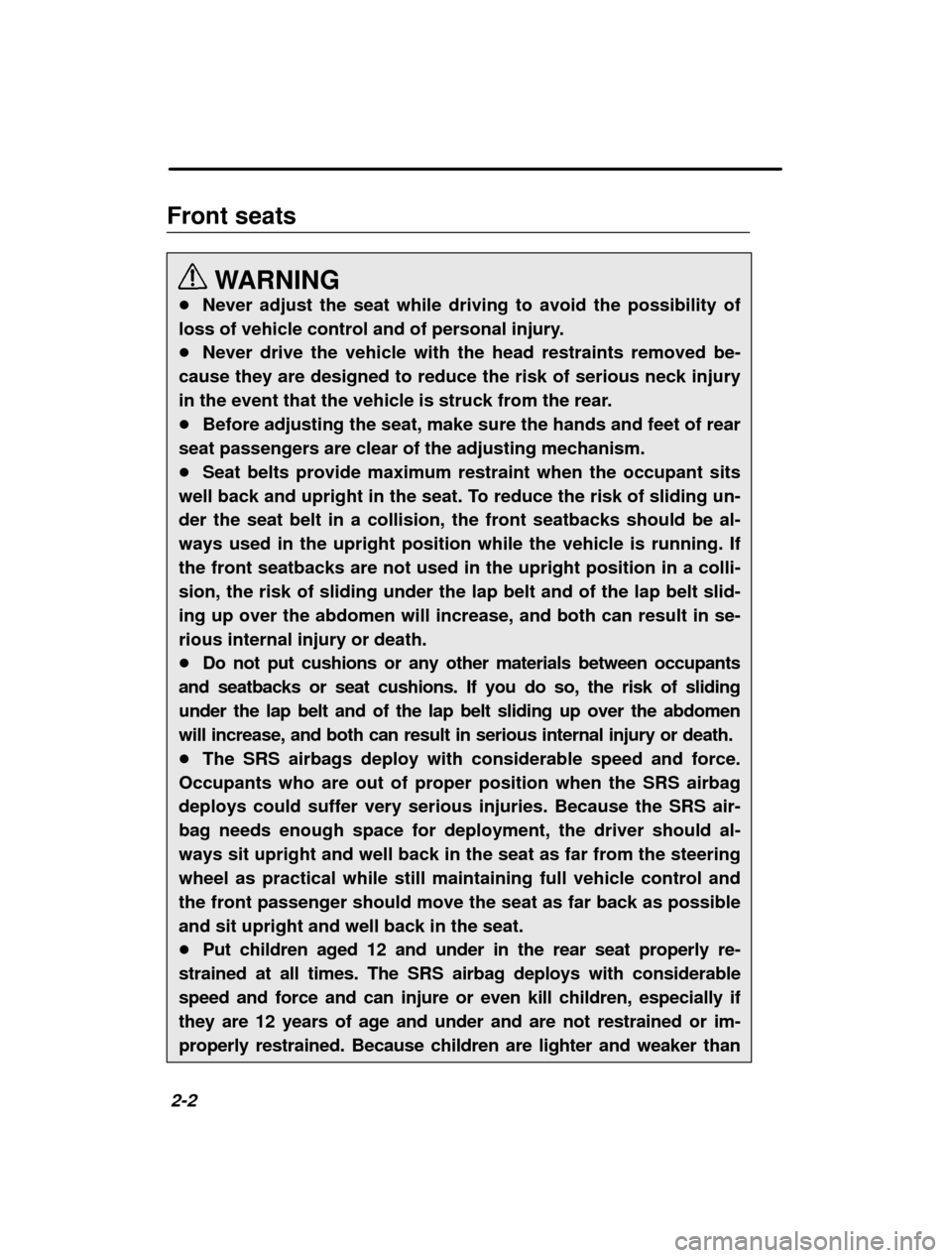
2-2
Front seats
WARNING
� Never adjust the seat while driving to avoid the possibility of
loss of vehicle control and of personal injury. � Never drive the vehicle with the head restraints removed be-
cause they are designed to reduce the risk of serious neck injury
in the event that the vehicle is struck from the rear.� Before adjusting the seat, make sure the hands and feet of rear
seat passengers are clear of the adjusting mechanism.� Seat belts provide maximum restraint when the occupant sits
well back and upright in the seat. To reduce the risk of sliding un-der the seat belt in a collision, the front seatbacks should be al-ways used in the upright position while the vehicle is running. Ifthe front seatbacks are not used in the upright position in a colli-
sion, the risk of sliding under the lap belt and of the lap belt slid-ing up over the abdomen will increase, and both can result in se-rious internal injury or death.� Do not put cushions or any other materials between occupants
and seatbacks or seat cushions. If you do so, the risk of sliding
under the lap belt and of the lap belt sliding up over the abdomen
will increase, and both can result in serious internal injury or death.� The SRS airbags deploy with considerable speed and force.
Occupants who are out of proper position when the SRS airbag
deploys could suffer very serious injuries. Because the SRS air-bag needs enough space for deployment, the driver should al-ways sit upright and well back in the seat as far from the steeringwheel as practical while still maintaining full vehicle control and
the front passenger should move the seat as far back as possibleand sit upright and well back in the seat.� Put children aged 12 and under in the rear seat properly re-
strained at all times. The SRS airbag deploys with considerable
speed and force and can injure or even kill children, especially if
they are 12 years of age and under and are not restrained or im-
properly restrained. Because children are lighter and weaker than
Page 60 of 316
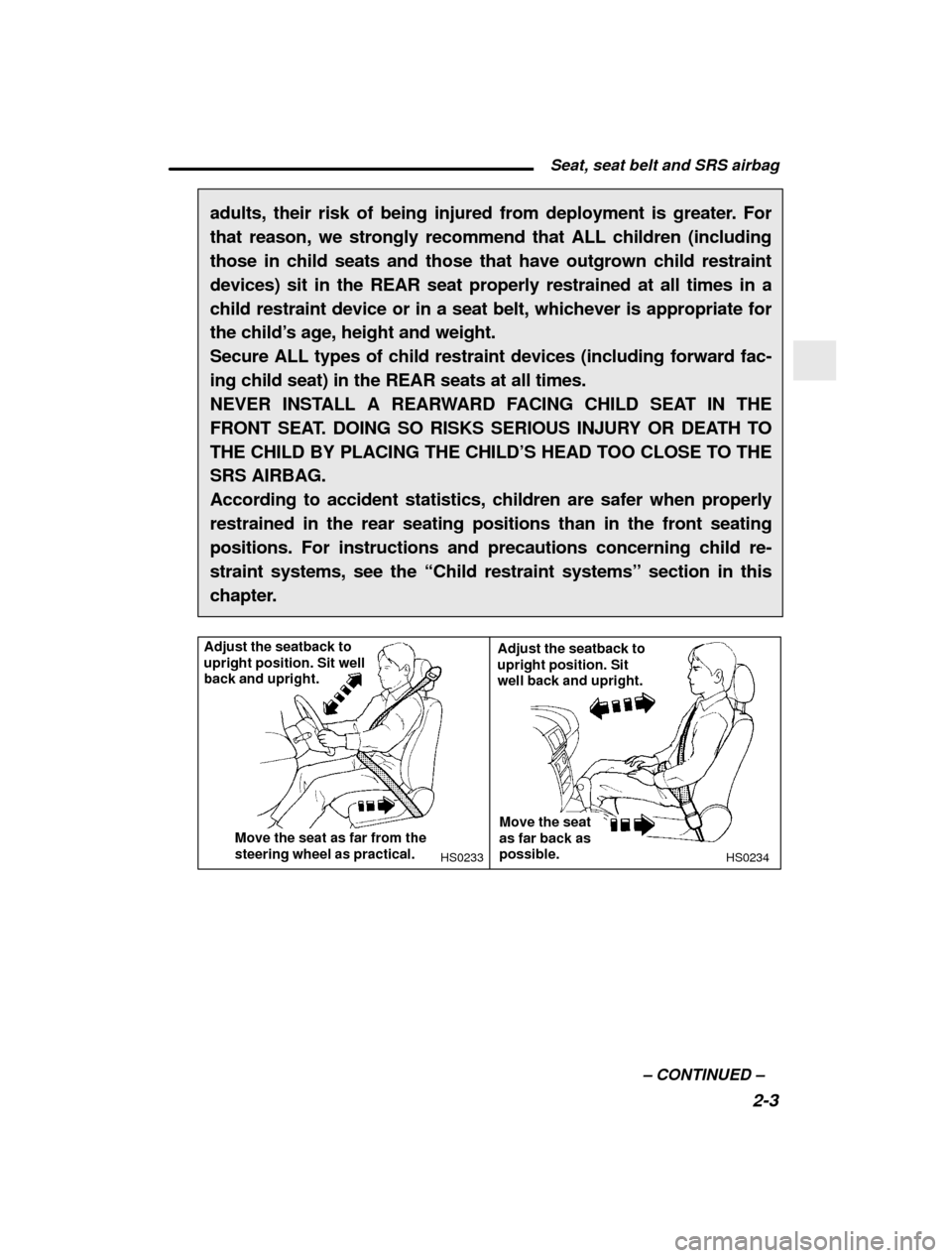
Seat, seat belt and SRS airbag2-3
–
CONTINUED –
adults, their risk of being injured from deployment is greater. For
that reason, we strongly recommend that ALL children (including
those in child seats and those that have outgrown child restraint
devices) sit in the REAR seat properly restrained at all times in a
child restraint device or in a seat belt, whichever is appropriate for
the child
’s age, height and weight.
Secure ALL types of child restraint devices (including forward fac-
ing child seat) in the REAR seats at all times.
NEVER INSTALL A REARWARD FACING CHILD SEAT IN THE
FRONT SEAT. DOING SO RISKS SERIOUS INJURY OR DEATH TO
THE CHILD BY PLACING THE CHILD ’S HEAD TOO CLOSE TO THE
SRS AIRBAG.
According to accident statistics, children are safer when properly
restrained in the rear seating positions than in the front seating
positions. For instructions and precautions concerning child re-
straint systems, see the “Child restraint systems ” section in this
chapter.
HS0234
HS0233
Adjust the seatback to upright position. Sit well back and upright.
Move the seat as far from the steering wheel as practical. Adjust the seatback toupright position. Sit well back and upright.Move the seat as far back as possible.
Page 72 of 316
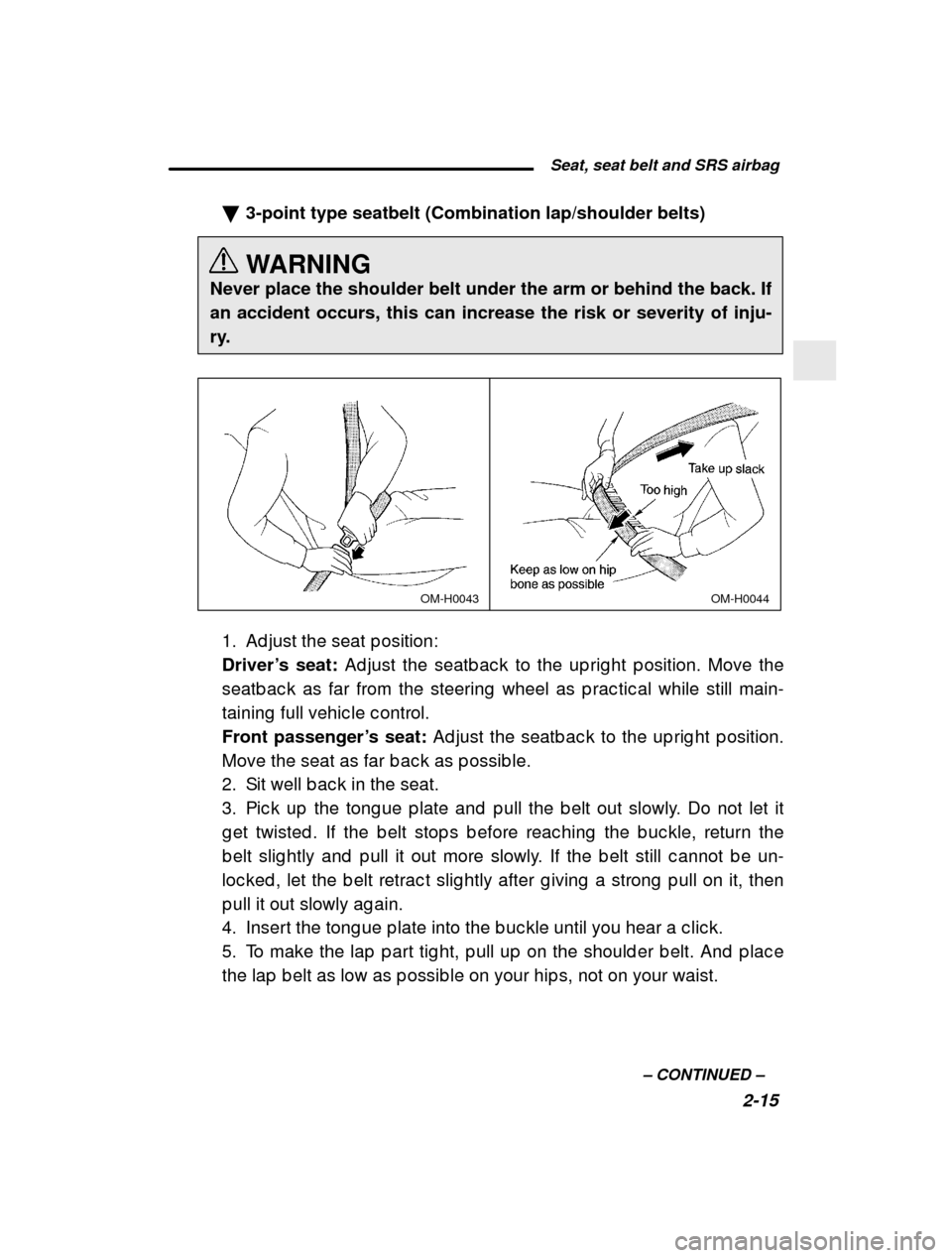
Seat, seat belt and SRS airbag2-15
–
CONTINUED –
�
3-point type seatbelt (Combination lap/shoulder belts)
WARNING
Never place the shoulder belt under the arm or behind the back. If an accident occurs, this can increase the risk or severity of inju-
ry.
OM-H0044OM-H0043
1. Ad just the seat p osition:
Driver’ s seat: Ad just the seatb ac k to the up rig ht p osition. Move the
seatb ac k as far from the steering wheel as p rac tic a l while still main-
taining full vehic le c ontrol.Front passenger ’s seat: Ad just the seatb ac k to the up rig ht p osition.
Move the seat as far b ac k as p ossib le.
2. Sit well b ac k in the seat.
3. Pic k up the tong ue p late and p ull the b elt out sl owly. Do not let it
g et twisted . If the b elt stop s b efore reac hing the b uc kle, return the
b elt slig htly and p ull it out more slowly. If the b elt still c annot b e un-
loc ked , let the b elt retrac t slig htly after g iving a strong p ull on it, then
p ull it out slowly ag ain.
4. Insert the tong ue p late into the b uc kle until you hear a c lic k.
5. To make the lap p art tig ht, p ull up on the should er b elt. And p lac e
the lap b elt as low as p ossib le on your hip s, not o n your waist.
Page 85 of 316
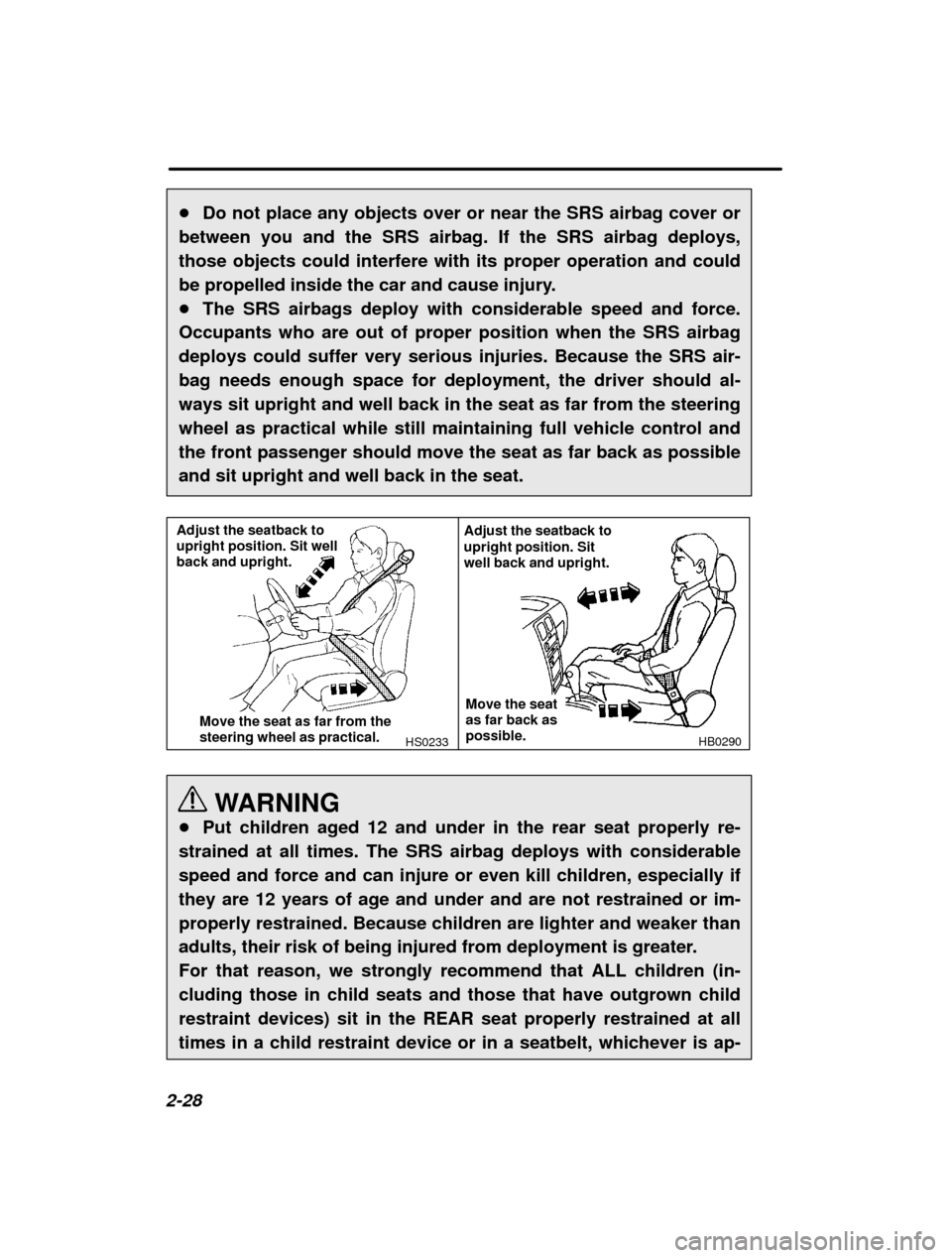
2-28�
Do not place any objects over or near the SRS airbag cover or
between you and the SRS airbag. If the SRS airbag deploys, those objects could interfere with its proper operation and could
be propelled inside the car and cause injury.� The SRS airbags deploy with considerable speed and force.
Occupants who are out of proper position when the SRS airbag
deploys could suffer very serious injuries. Because the SRS air-bag needs enough space for deployment, the driver should al-ways sit upright and well back in the seat as far from the steeringwheel as practical while still maintaining full vehicle control and
the front passenger should move the seat as far back as possibleand sit upright and well back in the seat.
HS0233
Adjust the seatback to upright position. Sit well back and upright.
Move the seat as far from the steering wheel as practical.HB0290
Adjust the seatback to upright position. Sit well back and upright.
Move the seat as far back as possible.
WARNING
� Put children aged 12 and under in the rear seat properly re-
strained at all times. The SRS airbag deploys with considerable speed and force and can injure or even kill children, especially ifthey are 12 years of age and under and are not restrained or im-properly restrained. Because children are lighter and weaker than
adults, their risk of being injured from deployment is greater.
For that reason, we strongly recommend that ALL children (in-cluding those in child seats and those that have outgrown child
restraint devices) sit in the REAR seat properly restrained at alltimes in a child restraint device or in a seatbelt, whichever is ap-